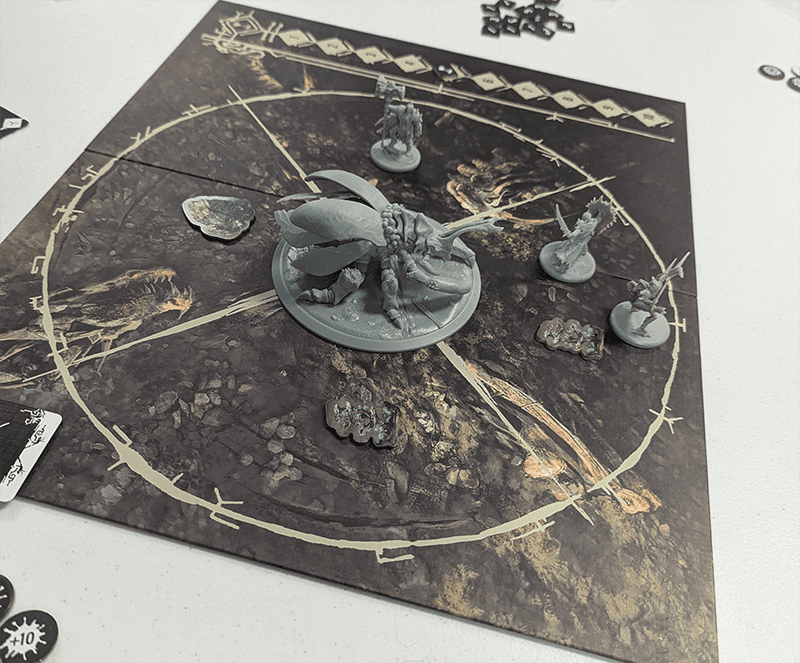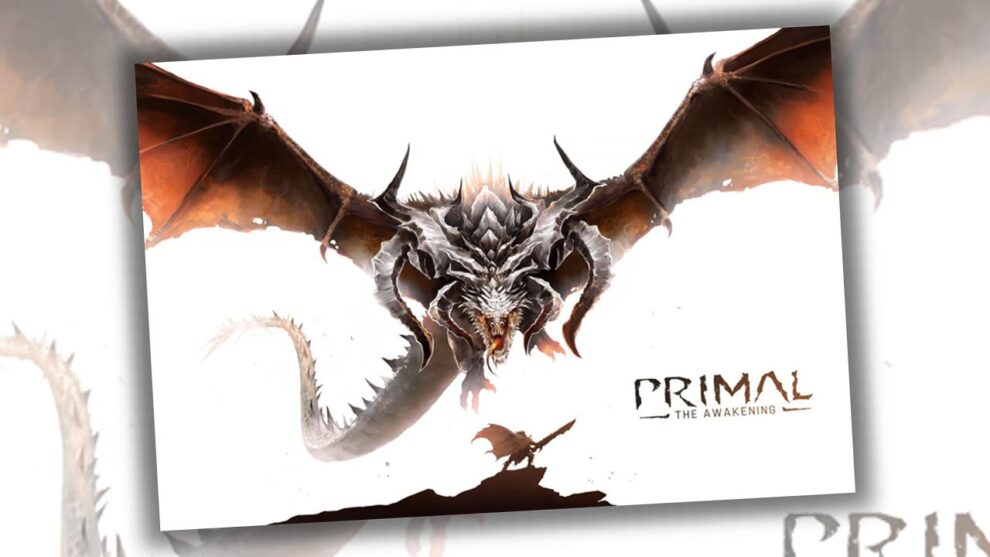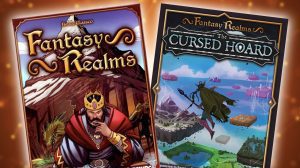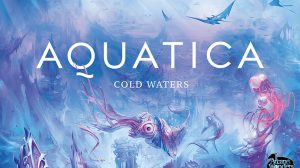Disclosure: Meeple Mountain received a free copy of this product in exchange for an honest, unbiased review. This review is not intended to be an endorsement.
Despite reviewing board games for nearly 5 years now and having written over 100 reviews, I never reviewed a campaign game. Time is a bit of a luxury for me, and campaign games have the daring proposal to subject me to hours of my time to get the “full experience” these behemoth boxes offer.
So why on earth am I reviewing this one? The answer is as simple as writing this sentence: I used to play the Monster Hunter video games back in the day. Much like how Nemesis is an unlicensed version of Aliens, Primal: The Awakening is an unlicensed version of Monster Hunter. However, that isn’t the only reason.
Campaign games have always irked me on their design. You see, a game calling itself a “dungeon crawler” or “boss battler,” and you think, “That’s my jam!” But then you’re stuck doing some bean-counting for upgrading a town or playing choose-your-own-adventure in between the good stuff. I’m here to skewer baddies, snatch their loot, beef up my gear, and then go skewer even bigger baddies. I want boss fights to feel like I’m a third monkey rushing towards Noah’s Ark because, brother, it is starting to rain.
Taming the Complexity
Fortunately for Primal: The Awakening, the campaign structure is exactly that. Your “prologue” is fighting a creature that is absolutely not Rathalos from Monster Hunter. Beat the fire dragon and the game gives you some flavor text, followed by your loot rewards, and plenty of options to craft new gear. Once you are done crafting, you pick a monster to do it all over again. You are going to do this twelve times to conclude your campaign.
Since this is a game review, of course I have to explain the gameplay. For the sake of my sanity, I am only going to give a general overview as the rulebook is roughly one hundred pages and the game’s complexity is mostly sensible.
Unlike many other boss battles, Primal: The Awakening doesn’t have a giant grid map. Right at the start of the fight, you are standing in front of the monster and the “map” itself is only four sectors, representing the Monster’s front, rear, and two flanks. During the fight, the monster rotates and some monsters can only be damaged in certain areas depending on their stance.
Monstrous Personality
Each monster has three stances and as your party damages the monster, the stances change representing the escalation of the fight. Initially, the creature might bolster its defenses, absorbing more punishment. As the fight intensifies, it may unveil new abilities and introduce additional combat mechanics or objectives for the players to take advantage of.
But enough about the monster, let’s talk about you, the hunter. There are four characters in the game, each with a unique weapon. These weapons are the game’s classes, such as the hammer doing high damage with crowd control or the sword and shield able to manipulate the monster’s facing. Besides having their own equipment, each character also has their own deck that gets upgraded as the campaign progresses.
As for a player’s turn, you simply play cards—as this is a hand management game. You discard cards from your hand to generate stamina to either play cards in your sequence or to move around the monster. Moving is quite taxing as you can only move one sector per turn and, if you don’t move, you are “threatened” meaning you have a higher chance of getting damaged by the monster at the end of your turn.
The cards revolve around four types, each serving a distinct purpose. Red cards deal damage, while Green and Yellow cards offer defensive options to mitigate incoming attacks. Blue cards, interestingly, reduce the monster’s Struggle—a resource akin to mana that the creature uses for powerful effects or to damage your party.

Hand Management With Teeth
Like any other card game, there is plenty of text to follow and keywords to memorize. Card abilities can trigger when cards are played in specific sequences, and your equipment can also set off their own abilities as well. As you can probably guess, the idea is to make the most efficient use of these abilities by utilizing the cards in your hand.
Some cards also allow you to play out of turn, such as “assist” cards to help your comrades, while others can give you Aggro. Aggro is important here as it not only determines who the first player is in the next round, but the Monster will rotate towards the Aggro player at the end of every player turn.
Now this is usually the part where I mention the monster attacks after the players are done, except that doesn’t exist. A big gimmick in Primal is its monster reaction system. Every monster not only has their own stances, they also have behavior cards. These behavior cards are numbered and have an icon representing a certain player action. If a player does that particular action, the monster reacts to it. To give a quick example, if it shows a Red attack icon, it means after a player has finished playing their Red attack card, the monster reacts.
The monster’s behavior cards are a critical element of combat that demand your attention. While some obviously threaten direct damage to your party, others introduce more nuanced challenges. These can include altering the battlefield, disrupting your hand of cards, or forcing changes in your team’s positioning relative to the creature. This system is designed to evoke the strategic depth found in Monster Hunter, where understanding and anticipating a creature’s behavior patterns becomes key to victory.
This overview only scratches the surface. The game’s complexity extends far beyond these basics, from status effects and creatures with distinct behavioral patterns to dynamic combat mechanics, elemental weaknesses, and an array of consumables and equipment. It is a game that offers a healthy level of complexity and abundance of content to play around with.
Navigating The Inconsistent
However, this abundance does have its drawbacks. After playing over half the campaign with one group and several one-shot expeditions with other groups at various player counts, I can’t help but have mixed feelings. There is plenty to enjoy here, and a lot to dislike as well.
One easy area I could comfortably point to is the player scaling. At two players, Primal is borderline pristine as the downtime is short and the state of the board doesn’t change much, making it easy to manage. Go beyond two players and you start seeing major issues.
Unlike other cooperative games, each player has complete agency of their turn. Since the card combos and hand management is intricate, you are always in isolation as you try to optimize your cards with little care about what the other players are doing. This may sound good on paper, yet the consequences of this design means you are not emotionally invested during another player’s turn, making the downtime noxious.
Combine this with the monster reaction system and it becomes an issue that cannot be ignored. As your allies trigger various monster effects, you may find your carefully laid plans disrupted when your turn arrives. These reactions can force card discards, alter terrain, or impose other unforeseen consequences.
In fact, the prologue fire dragon I mentioned before showcases this. Some of its reactions put fire in a sector, and if you are in a sector with fire, you cannot play cards in your sequence. In extreme scenarios, you might find yourself surrounded by flames, both in your current position and adjacent sectors. All you do at that point is move and end your turn, with the only true cost being ten minutes of your life.
Tag Teaming Greatness
Yet in a two-player setting, these problems evaporate. Downtime is respectable, as it gives you enough time to plan on what you are doing with little dead air. The game state doesn’t shift so much between turns since it’s only one player causing the monster’s reactions instead of three. In this foundation, a sense of intimate partnership emerges, as you and your teammate strategize together and discuss several solutions to a big violent problem that nests itself in the center of the table. This collaboration transforms a typical monster-fighting experience into a shared adventure, giving room for creative problem solving and memorable moments through triumphs and hardships. After playing this several times at various player counts, I can understand why there was plenty of praise of this game by people who primarily play this at two players.
One thing I also noticed throughout the various reviews is the reaction to complexity of the game. Mine isn’t that different. Yes, this is a complex game, but mainly for the wrong reasons. The way the graphics are displayed on the cards and components sprawl all over the table makes it extremely demanding to ensure you are playing the game properly. Your eyes are constantly darting around the table, keeping track of reactions and following proper procedures.
Perhaps the biggest offense is the use of the keywords. Primal loves to flashbang you with keywords that require you to take a trip to the glossary section to figure out what they mean. Since these are words and not icons, they easily camouflage with the rest of the card text. It didn’t surprise me at all that my first few games were a battle to ensure that I was playing the game properly. Even the Terrain pieces themselves have their own rules that you need to look up, and there are over a dozen icons for the monster reactions.

Evolution of Challenge
Even so, the game’s complexity is precisely what breathes life into its world, allowing it to soar beyond simple mechanics. Each creature possesses a distinct character that players must learn to navigate and conquer. Some adversaries demand strategic positioning for maximizing turn efficiency, while others behave like a shark on four legs, homing in on the most vulnerable player. The sheer variety of monster behaviors keeps encounters fresh and challenging. It is even more impressive when you realize that each monster has four variations, representing the four difficulties as you traverse the campaign.
Ah yes, the campaign, finally! As I’ve mentioned previously, the campaign structure is essentially escorting the giant monsters to the afterlife through violent methods, carving up their bits, upgrading your gear, and doing it all over again. There is a bit more to it than that.
For starters, each monster has an element associated with it. When you win a fight against a monster with a new element, it opens up a new “forge” to craft your equipment from. These items aren’t simple number changes, as they introduce brand new abilities to take advantage of. Even now where I am past the half point of my campaign, I have access to dozens of items to choose from. To some people, this is overwhelming, but as a fan of the Monster Hunter series, it’s exactly what I’m looking for.
There is also a surprising amount of replayability here. When you start the campaign, you have a small list of monsters to fight and the order you choose to fight them in not only opens up a new path to fight other monsters, but also changes what type of equipment you can make along the way. Some monsters also grant reward cards, giving you new items to play with. Throw in pre-game deckbuilding and you have an astoundingly meaty campaign with a straightforward structure.
A Campaign Of Oddities
This grass isn’t as green everywhere though. While I certainly welcome the simplicity, it feels a bit repetitive, as all you are doing is fighting monsters over and over again with more complex mechanics and higher numbers to calculate. I don’t mind it so much, but I would be lying if I said that some of my players for this review aren’t retreating from the experience. What I can’t excuse is its attempt to take its plot seriously.
The original Monster Hunter games never had grand stories as they merely exist to give some flimsy excuse to facelift the ecosystem through excessive violence. Primal: The Awakening is trying to take itself too seriously with flavor text that overstays its welcome and even outright telling you about “having a discussion with your friends about the plot” before reading the first rule of the campaign.
While the written text is fine, the biggest issue I have is that most of the text is putting the players into the role of observers indulging in the ‘drama’ of the story instead of active participants. More telling, less showing. It was so exhausting that we eventually started skipping the flavor text and going straight to the rules of the monster encounter and any rewards for beating it.
Of course, this begs a single question that I’m sure is in everyone’s minds: Is this worth the high price tag? Sadly, I can’t give an honest answer to that because I don’t buy campaign games overall and this was a review copy provided by the publisher, but I can offer some guidance.
My Brand Of Butter
While I’ve explored complex tabletop games like Gloomhaven, Kingdom Death Monster, and Aeon Trespass Odyssey, their intricate designs often left me feeling overwhelmed rather than engaged. The constant upkeep required during play sessions and the labyrinthine rule sets proved more daunting than inviting for me personally.
In contrast, Primal: The Awakening has captured my interest, convincing me to see its campaign to its conclusion. Its combat system and overall structure strike a balance that resonates with my preferences. I find myself engrossed in its character customization options and the strategic planning for upcoming encounters. The game embraces its identity as a “boss battler” without unnecessarily complicating itself with various systems. While some might find it too streamlined, its concentrated design aligns perfectly with my gaming tastes, offering respectable depth.
Primal: The Awakening is a good example of focused game design. While it may not boast the sprawling complexity of some of its peers in the genre, it excels in delivering a satisfying blend of compelling depth and reasonable accessibility. For players seeking a boss battler without the excess fluff, Primal offers a good alternative if you are willing to stick to two players even with its many warts.










